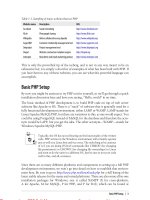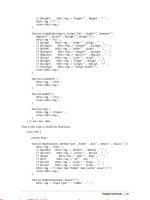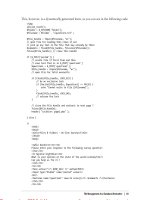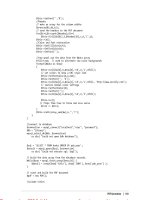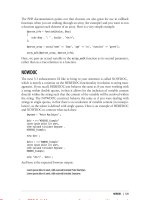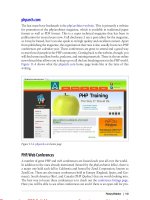PHP: The Good Parts potx
Bạn đang xem bản rút gọn của tài liệu. Xem và tải ngay bản đầy đủ của tài liệu tại đây (5.54 MB, 176 trang )
Please purchase PDF Split-Merge on www.verypdf.com to remove this watermark.
Please purchase PDF Split-Merge on www.verypdf.com to remove this watermark.
PHP: The Good Parts
Peter B. MacIntyre
Beijing
•
Cambridge
•
Farnham
•
Köln
•
Sebastopol
•
Taipei
•
Tokyo
Please purchase PDF Split-Merge on www.verypdf.com to remove this watermark.
PHP: The Good Parts
by Peter B. MacIntyre
Copyright © 2010 Peter B. MacIntyre. All rights reserved.
Printed in the United States of America.
Published by O’Reilly Media, Inc., 1005 Gravenstein Highway North, Sebastopol, CA 95472.
O’Reilly
books may be purchased for educational, business, or sales promotional use. Online editions
are also available for most titles (). For more information, contact our
corporate/institutional sales department: 800-998-9938 or
Editor: Julie Steele
Production Editor: Adam Zaremba
Copyeditor: Amy Thomson
Proofreader: Adam Zaremba
Indexer: Seth Maislin
Cover Designer: Karen Montgomery
Interior Designer: David Futato
Illustrator: Robert Romano
Printing History:
April 2010:
First Edition.
Nutshell Handbook, the Nutshell Handbook logo, and the O’Reilly logo are registered trademarks of
O’Reilly
Media, Inc. PHP: The Good Parts, the image of a Booted Racket-tail, and related trade dress are
trademarks of O’Reilly Media, Inc.
Many of the designations used by manufacturers and sellers to distinguish their products are claimed as
trademarks. Where those designations appear in this book, and O’Reilly Media, Inc. was aware of a
trademark claim, the designations have been printed in caps or initial caps.
While every precaution has been taken in the preparation of this book, the publisher and author assume
no responsibility for errors or omissions, or for damages resulting from the use of the information con-
tained herein.
TM
This book uses RepKover™, a durable and flexible lay-flat binding.
ISBN: 978-0-596-80437-4
[M]
1270572274
Please purchase PDF Split-Merge on www.verypdf.com to remove this watermark.
I dedicate this book to my wonderful wife,
Dawn Etta Riley.
I love you!
Please purchase PDF Split-Merge on www.verypdf.com to remove this watermark.
Please purchase PDF Split-Merge on www.verypdf.com to remove this watermark.
Table of Contents
Foreword .
. . . . . . . . . . . . . . . . . . . . . . . . . . . . . . . . . . . . . . . . . . . . . . . . . . . . . . . . . . . . . . . . . . ix
Preface . . . . . . . . . . . . . . . . . . . . . . . . . . . . . . . . . . . . . . . . . . . . . . . . . . . . . . . . . . . . . . . . . . . . xiii
1. The Good Parts . . . . . . . . . . . . . . . . . . . . . . . . . . . . . . . . . . . . . . . . . . . . . . . . . . . . . . . . . 1
Why PHP? 1
A Brief History of PHP 1
PHP’s Place in the World 2
What Is PHP? 2
What Has Been Accomplished with PHP? 2
Basic PHP Setup 3
2. Casing the Joint . . . . . . . . . . . . . . . . . . . . . . . . . . . . . . . . . . . . . . . . . . . . . . . . . . . . . . . . . 7
Whitespace, Comments, and Basic Syntax 7
Variables: Data Types, Loose Typing, and Scope 9
Defined Constants 11
Expressions 13
Decisions, Decisions (Flow Control) 13
If Else 14
Switch Case 16
While 18
For 19
Integration with Web Pages 19
Cookies 20
Sessions 21
$_GET 22
$_POST 23
$_REQUEST 24
3. Functions (Doing It Once) .
. . . . . . . . . . . . . . . . . . . . . . . . . . . . . . . . . . . . . . . . . . . . . . . 27
Parameter Passing 27
v
Please purchase PDF Split-Merge on www.verypdf.com to remove this watermark.
Default Parameters 29
Passing by Value Versus Passing by Reference 30
Include and Require 31
Built-In Functions Versus UDFs 32
4. Strings . . . . . . . . . . . . . . . . . . . . . . . . . . . . . . . . . . . . . . . . . . . . . . . . . . . . . . . . . . . . . . . 33
What Is a String? 33
You Can Quote Me 34
String Functions (Best of) 36
String Trimmings 36
Character Case Management 38
String Content Searching 39
String Modification 40
5. Arrays . . . . . . . . . . . . . . . . . . . . . . . . . . . . . . . . . . . . . . . . . . . . . . . . . . . . . . . . . . . . . . . . 45
Indexed Arrays 45
Associative Arrays 46
Arrays from Another Dimension 47
Arrays Can Be Dynamic 48
Traversing Arrays 50
Array Functions (Best of) 51
Sorting Arrays 51
Math-Type Functions 53
Array Potpourri 54
6. Objects . . . . . . . . . . . . . . . . . . . . . . . . . . . . . . . . . . . . . . . . . . . . . . . . . . . . . . . . . . . . . . . 59
Putting It into Practice 60
Magic Methods 65
$this 66
Objects in Action 67
Public, Protected, and Private 68
Getters and Setters 69
7. Database Interaction . . . . . . . . . . . . . . . . . . . . . . . . . . . . . . . . . . . . . . . . . . . . . . . . . . . 71
MySQLi Object Interface 71
Retrieving Data for Display 73
PHP Data Objects 74
PDO Prepared Statements 75
Data Management on the Cheap 77
SQLite 77
File Management As a Database Alternative 79
vi | Table of Contents
Please purchase PDF Split-Merge on www.verypdf.com to remove this watermark.
8. PHP and Friends . . . . . . . . . . . . . . . . . . . . . . . . . . . . . . . . . . . . . . . . . . . . . . . . . . . . . . . 89
Email/SMS Generation 89
PDF Generation 92
Constructor Method and Basic Document Options 96
Adding Document Headers and Footers 96
Adding Images and Links 97
Adding a Watermark 101
Dynamic PDFs and Table Display 102
Graphical Reports Generation 105
Pie Charts 105
Bar Charts 107
Captchas 109
9. PHP Security . . . . . . . . . . . . . . . . . . . . . . . . . . . . . . . . . . . . . . . . . . . . . . . . . . . . . . . . . 111
Data Validation 111
Escape Output 113
Cross-Site Scripting (XXS) and SQL Injection 115
Password Encryption Security 116
Security Tips 117
10. PHP 5.3 Good Parts . . . . . . . . . . . . . . . . . . . . . . . . . . . . . . . . . . . . . . . . . . . . . . . . . . . . 119
Namespaces 119
Closures (Anonymous Functions) 122
NOWDOC 123
goto Operator 124
DateTime and DateTimeZone Classes 126
Additional 5.3 Features 131
11. Advanced Goodness . . . . . . . . . . . . . . . . . . . . . . . . . . . . . . . . . . . . . . . . . . . . . . . . . . . 133
Regular Expressions 133
String Matching 133
String Substituting 135
String Splitting 135
SimpleXML 136
Integrated Development Environments 138
Komodo by ActiveState 139
Zend Studio for Eclipse 139
PhpED by NuSphere 140
Primary Websites 140
php.net 140
zend.com 141
devzone.zend.com 141
phparch.com 143
Table of Contents | vii
Please purchase PDF Split-Merge on www.verypdf.com to remove this watermark.
PHP/Web Conferences 143
Appendix: The Bad Parts . . . . . . . . . . . . . . . . . . . . . . . . . . . . . . . . . . . . . . . . . . . . . . . . . . . . . 145
Index . . . . . . . . . . . . . . . . . . . . . . . . . . . . . . . . . . . . . . . . . . . . . . . . . . . . . . . . . . . . . . . . . . . . . 149
viii | Table of Contents
Please purchase PDF Split-Merge on www.verypdf.com to remove this watermark.
Foreword
Why, you might ask, do we need yet another book on PHP? And why, now, is it relevant
to point out the “good parts?” Well, this is not just any book, and this is not just any
time in the life of PHP. PHP is gaining adoption more rapidly now than ever before,
and there are progressively more people who want to know what PHP is and to un-
derstand its popularity. With the continuous shift of individuals and enterprises to-
wards deeper adoption of PHP, it is important for the world to have a quick read (and
reference) to get the basics of the language before committing to deeper works, larger
projects, or training. This is that book. No matter who or what you are today—a non-
programmer, a Java programmer, or an RPG programmer—there is no better place to
quickly start to understand what is good about PHP. Once you have this under your
belt, decisions on how to move forward with or without PHP—and whether to delve
into it at a deeper level—should become much easier.
I have spent the last three years and more working side-by-side with the team that
brought PHP to a place where it could easily be used in business, and I have seen the
many ways in which PHP has offered great benefits to enterprises. One example was a
single sign-on portal for 1,800 auto dealers and 2,400 service centers (comprising over
42,000 users) to be able to customize, order, and service consumer vehicles in 17 coun-
tries across Europe. Integrating 15 disparate software applications to communicate
with backend systems is a challenge in any language, but PHP offered a rapid turn-
around, quick time-to-market “glue” language solution that enabled this enterprise to
accomplish its goals in short order and with cost savings over other possible solutions.
In my former position as the VP of Global Services at Zend Technologies, the progres-
sively increasing demand for PHP within enterprises led us to develop a full portfolio
of service offerings, including a strong curriculum of training courses. There was a
similar demand from individual developers who benefited from these offerings as well
and, despite the recent economic environment (or maybe because of it), we saw no dip
in student registration and attendance. I would recommend this book as an excellent
precursor to any of those courses.
Peter MacIntyre has, for many years, been instrumental in helping many people gain
the benefits of PHP through his writing, teaching, and speaking engagements. I had the
pleasure of meeting Peter about three years ago, when I was introduced to him by
ix
Please purchase PDF Split-Merge on www.verypdf.com to remove this watermark.
colleagues at Zend. Peter had completed a couple of webinars for us and my colleagues
felt so strongly about his ability to convey valuable information that they believed he
would make a great addition to our training team. Since that time, I have continued to
watch the many ways in which Peter has spread the word about the ease of using PHP,
the many associated technologies and tools available, and the many avenues through
which to learn it. He is an ardent user of this technology and knows it and all its asso-
ciated technologies extremely well.
Peter, in this book, mentions some of the larger visible applications (such as Facebook
and Yahoo!), and throughout my involvement with PHP I have seen many large or-
ganizations (including JC Penney, Best Buy, DHL, Fox Interactive, GE, and Deutsche-
Telecom) use PHP in many ways that show the power of this simple language. Think
job opportunities! If you plan to focus on using PHP to develop a career or expand it,
you will be interested to know that in conversations with companies like ODesk, I
learned that, of all the skills in demand through that site, PHP was one of the top and
was at that time generating the highest rate per hour. Rates ran higher for those with a
Zend Certified Engineer certification.
I think the most amazing adoption of PHP to date has been that of the IBMi/RPG world.
It has been very rewarding to see nonprocedural programmers come into the new age
of web development, first with a slight struggle, perhaps, but then with total eagerness
once they see what modern interfaces they can provide to their users (or clients), with
functionality as sophisticated as PHP can provide on the IBMi. So, if you are an IBMi
user or an RPG programmer, buy this book now and you’ll soon find yourself under
the spell of PHP. Green screens can be modernized and your applications can live on.
What if you are a strong Java programmer and PHP is just, well, “beneath” you? This
is always a fun discussion for all us PHP believers! I have heard a number of funny lines:
“PHP is not Java” and “Java is dead” and then, from the other side, “PHP is for
hobbyists.” But all one has to look at is the ramp-up rate of downloads for the Zend
Framework, Magento, or Drupal to realize that the simplicity of PHP belies its power
and potential. PHP is not a replacement for Java, nor can Java do what PHP can do.
These two languages live side-by-side for each of the most successful and leading-edge
IT teams. One note of warning, though: read this book carefully—there are different
ways to use PHP than a Java programmer would assume based on Java, and this book
will guide you on how to leverage PHP for the best results.
Today, over a third of the world’s websites are written in PHP, and that number is
growing. The language itself has evolved to where it has a complete development in-
frastructure in place, enabling its sophisticated application to business; Zend Frame-
work, Magento, and Drupal are all very successful examples of this evolution. Market
analyst Gartner recently published a report for their clients that forecasted the PHP
worldwide developer count to grow to as high as 5 million developers by 2013 (up from
3 million in 2007 and 4 million in 2009). They also provided a short-term forecast
indicating that PHP will remain a widely adopted web development technology.
x | Foreword
Please purchase PDF Split-Merge on www.verypdf.com to remove this watermark.
It is time for more people, and for you, to understand what is behind this buzz. So I
invite you to go ahead: read on, enjoy, and join the growing family of PHP users! You
won’t go back.
—Susie Sedlacek
Former VP of Global Services, Zend Technologies
Foreword | xi
Please purchase PDF Split-Merge on www.verypdf.com to remove this watermark.
Please purchase PDF Split-Merge on www.verypdf.com to remove this watermark.
Preface
Conventions Used in This Book
The following typographical conventions are used in this book:
Italic
Indicates new terms, URLs, email addresses, filenames, and file extensions.
Constant width
Used for program listings, as well as within paragraphs to refer to program elements
such as variable or function names, databases, data types, environment variables,
statements, and keywords.
Constant width bold
Shows commands or other text that should be typed literally by the user.
Constant width italic
Shows text that should be replaced with user-supplied values or by values deter-
mined by context.
This icon signifies a tip, suggestion, or general note.
This icon indicates a warning or caution.
Using Code Examples
This book is here to help you get your job done. In general, you may use the code in
this book in your programs and documentation. You do not need to contact us for
permission unless you’re reproducing a significant portion of the code. For example,
writing a program that uses several chunks of code from this book does not require
permission. Selling or distributing a CD-ROM of examples from O’Reilly books does
xiii
Download at Wow! eBook
Please purchase PDF Split-Merge on www.verypdf.com to remove this watermark.
require permission. Answering a question by citing this book and quoting example
code does not require permission. Incorporating a significant amount of example code
from this book into your product’s documentation does require permission.
We appreciate, but do not require, attribution. An attribution usually includes the title,
author, publisher, and ISBN. For example: “PHP: The Good Parts by Peter B.
MacIntyre. Copyright 2010 Peter B. MacIntyre, 978-0-596-80437-4.”
If you feel your use of code examples falls outside fair use or the permission given above,
feel free to contact us at
How to Contact Us
Please address comments and questions concerning this book to the publisher:
O’Reilly Media, Inc.
1005 Gravenstein Highway North
Sebastopol, CA 95472
800-998-9938 (in the United States or Canada)
707-829-0515 (international or local)
707-829-0104 (fax)
We have a web page for this book, where we list errata, examples, and any additional
information. You can access this page at:
/>To comment or ask technical questions about this book, send email to:
For more information about our books, conferences, Resource Centers, and the
O’Reilly Network, see our website at:
Safari® Books Online
Safari Books Online is an on-demand digital library that lets you easily
search
over 7,500 technology and creative reference books and videos to
find the answers you need quickly.
With a subscription, you can read any page and watch any video from our library online.
Read books on your cell phone and mobile devices. Access new titles before they are
available for print, and get exclusive access to manuscripts in development and post
feedback for the authors. Copy and paste code samples, organize your favorites,
download chapters, bookmark key sections, create notes, print out pages, and benefit
from tons of other time-saving features.
xiv | Preface
Please purchase PDF Split-Merge on www.verypdf.com to remove this watermark.
O’Reilly Media has uploaded this book to the Safari Books Online service. To have full
digital access to this book and others on similar topics from O’Reilly and other pub-
lishers, sign up for free at .
Acknowledgments
I would first like to thank all those folks at O’Reilly who are involved in books and
never really get a pat on the back. I don’t even know who you all are, but thanks for all
of your work to help get this project done (and done well), and to finally make it to the
bookshelves. The editing, graphics work, layout, planning, marketing, and so on all
have to be done, and I appreciate your work toward this end.
To Julie Steele, my acquisitions editor at O’Reilly, who always showed great patience
and professionalism on this project, thanks for giving me this opportunity and for
working with me from start to finish. I think I could now consider you to be one of my
better friends in the IT publishing business. One day I hope to meet you in person!
Much thanks to my technical editors, too. Charles Tassell, Brian Danchilla, and Peter
Lavin, thanks for your keen eyes and for thoroughly testing my many lines of sample
code. Many of your great pointers and ideas were used to make this book better. Wez
Furlong and Derick Rethans also contributed some technical pointers; thanks for your
assistance as well.
Finally, to Susie Sedlacek, former Vice President, Global Services, Zend Corporation—
thanks for being willing to put together an introduction for this book. I was keen to
have you do the introduction so that readers could get a global perspective on the ever-
growing, worldwide use and impact of PHP. I was happy to hear that you and your
husband have purchased a vineyard in California, and I hope that you really enjoy that
new endeavor!
Preface | xv
Please purchase PDF Split-Merge on www.verypdf.com to remove this watermark.
Please purchase PDF Split-Merge on www.verypdf.com to remove this watermark.
CHAPTER 1
The Good Parts
This book has been a rather long time in the making. I have been using PHP for many
years now, and have grown to love it more and more for its simplistic approach to
programming, its flexibility, and its power. Of all the programming languages I have
used throughout my over 20-year career, PHP is my favorite, hands down. PHP has
grown from a small set of functions to a very large volume of functions, external inter-
faces, and add-on tools. Some programmers may be overwhelmed by its apparent vast-
ness, but I hope to show you in this book that most of the PHP world can indeed be of
great use. In a relatively short amount of pages, you will be shown all the best areas of
the PHP development environment. By the time you get to the last page, you will have
a better understanding of how powerful that environment is in the web development
sphere.
Why PHP?
With so many programming books on the market these days—and so many PHP
books—you might wonder what another book could accomplish. PHP is a widely used
language and has experienced much growth in recent years in the enterprise market.
Web environments like Facebook, Flickr, portions of Yahoo!, and Wikipedia all use
PHP in a significant way, and web content management systems like Drupal, Joomla,
and WordPress are also powered by PHP. IBM is also showing a lot of interest in inte-
grating its technologies with PHP. For these reasons, it makes sense for the community
to assist beginning and intermediate programmers in becoming familiar with all the
best areas of this language.
A Brief History of PHP
Let’s start with a brief history of the language. Personal Home Page (PHP), initially
known as PHP Tools, was launched in June 1995 by Rasmus Lerdorf. It was originally
launched as open source software and remains so to this day. Database integration was
implemented in version 2.0 in 1996, and the product has grown by leaps and bounds
1
Download at Wow! eBook
Please purchase PDF Split-Merge on www.verypdf.com to remove this watermark.
ever since. Its worldwide use is higher than any other web development language. As
of this writing, the latest version of PHP is 5.3, which was released on June 30, 2009.
PHP’s Place in the World
PHP is one of the most widely used programming languages in the world. To think that
it has grown this much in such a short period of time is quite impressive; in just 15
years or so, it has grown to be one of the major players in the web development world.
In the last several years, many members of the PHP community have been debating
whether the language is enterprise ready: can it be trusted to handle the big projects
and weights? Given the recent focus on PHP from companies like IBM and Microsoft,
and the fact that it powers the largest websites in the world (Facebook and Yahoo!),
one could argue that it is already in the enterprise. This debate will be resolved over
time, but with version 5.3 just recently having been released, it is a safe bet to say that
if it isn’t, it very soon will be.
What Is PHP?
So what is PHP anyway? It is a scripting language, mostly used on the server side, that
can be employed to generate Hypertext Markup Language (HTML) information dy-
namically. PHP is connected to a web server, generally Apache or Internet Information
Server (IIS), and once it has finished generating proper HTML, it sends its creation back
to the web server for delivery to the requesting client.
I say “mostly used” on the server side because you can use PHP in many other areas,
including command line, desktop PC, and client server environments, just to name a
few. However, it is most commonly used in the web server environment.
PHP developers can also integrate PHP with one of many different database tools like
MySQL, SQLite, PostgreSQL, DB2, MS SQL, ORACLE, and so on, to make their cre-
ated content as dynamic as possible. In reality, what is produced is still a static HTML
file, but it is produced on the fly and therefore seems to be dynamic. Actually, one could
argue that since the content is dynamically drawn out of a database or some other data
source, PHP is in fact creating dynamic content.
What Has Been Accomplished with PHP?
Now, saying all these things about PHP and not having any proof would be untoward
for sure, so let’s take a quick highlight tour of what has been built and accomplished
with PHP. Some of the major and most popular web locations in the world are powered
at some level by PHP. Table 1-1 includes a short list of popular websites, their Uniform
Resource Locators (URLs), and a brief description of what each does.
2 | Chapter 1: The Good Parts
Please purchase PDF Split-Merge on www.verypdf.com to remove this watermark.
Table 1-1. Sampling of major websites that use PHP
Website name Description URL
Facebook Social networking
Flickr Photograph sharing
Wikipedia Online collaborative encyclopedia
SugarCRM Customer relationship management tool
Dotproject Project management tool
Drupal Website construction template engine
Interspire Newsletter and email marketing product
This is only the proverbial tip of the iceberg, and is not in any way meant to be an
exhaustive list; it is simply a short list of examples of what has been built with PHP. If
you have been to any of these websites, you can see what this powerful language can
accomplish.
Basic PHP Setup
By now you might be anxious to try PHP out for yourself, so we’ll go through a quick
installation discussion here and have you saying, “Hello, world” in no time.
The basic method of PHP development is to build PHP code on top of web server
software like Apache or IIS. There is a “stack” of software that is generally used for a
fully functional development environment: either LAMP or WAMP. LAMP stands for
Linux/Apache/MySQL/PHP, but there are variations to this, as one would expect. You
could be using PostgreSQL instead of MySQL for the database and therefore the acro-
nym would be LAPP, but you get the idea. The other acronym—WAMP—stands for
Windows/Apache/MySQL/PHP.
Typically, the OS has no real bearing on the functionality of the written
code. PHP written in the Windows environment will certainly operate
just as well on a Linux box and vice versa. The only thing to be cautious
of is if you are doing OS-level commands like CHMOD (for changing
file permissions) or CHOWN (for changing file ownerships) in Linux
and want to do the same in a different OS. Just be sure to test your code
well in this, and all, instances.
Since there are so many different platforms and components to setting up a full PHP
development environment, we won’t go into detail on how to establish that environ-
ment here. Be sure to go to for a full listing of the
latest stable releases for the many and varied platforms. There are also some all-in-one
installation packages for Windows; one is called XAMPP (X for cross-platform,
A for Apache, M for MySQL, P for PHP, and P for Perl), which can be found at
Basic PHP Setup | 3
Please purchase PDF Split-Merge on www.verypdf.com to remove this watermark.
After you have the package for
the appropriate platform, look for a file called install.txt among the downloaded files
for a setup guide.
Once you have PHP installed, you should be able to run a small script that will interpret
your php.ini settings file and show you all your directives and setting values. The code
for doing this is one line, like so:
<?php phpinfo() ; ?>
The way to start and stop PHP content is with the <?php text sequence and the ?> text
sequence, respectively, but more on that in the next chapter. For now, save this code
in your web root folder (usually www or htdocs) as phpinfo.php. When you enter http:
//localhost/phpinfo.php in the browser, the output should resemble Figure 1-1.
Take some time to review these settings, and don’t worry if you are not sure what most
of them are; simply having a screen that looks like Figure 1-1 is proof enough that PHP
is properly installed and being served through your localhost web server.
Localhost is the web address prefix for all the PHP code you write in
your
local computer environment. If you have code running off of a
remote server, you either reference it with a proper web address or a
specific IP number.
Now let’s write a little code here to do the proverbial worldwide greeting. Open a file
called HelloOutThere.php under the document root—typically, this is /var/www/ in
Linux or /apache2/htdocs in Windows—and enter the following code:
<?php echo "Hello, is there anybody out there?" ; ?>
Then enter the following into the browser’s address field: http://localhost/HelloOut
There.php. The result should be a browser page similar to Figure 1-2.
What we are telling the web server to do here is to repeat (echo) something into the
browser’s display area. With the echo command, we can send a string of text or, as you
will see later in this book, almost anything within the web context. That’s all there is
to it. You have just created your first PHP web page.
4 | Chapter 1: The Good Parts
Please purchase PDF Split-Merge on www.verypdf.com to remove this watermark.
Figure 1-1. Result of phpinfo() function
Basic PHP Setup | 5
Please purchase PDF Split-Merge on www.verypdf.com to remove this watermark.
Figure 1-2. HelloOutThere.php example browser output
6 | Chapter 1: The Good Parts
Please purchase PDF Split-Merge on www.verypdf.com to remove this watermark.
CHAPTER 2
Casing the Joint
Now that you know the very basics of a PHP file, how to run it through a web server,
and how to display some content in a web browser, let’s look more closely at the lan-
guage’s building blocks and how you can use them to construct larger, more complex
websites and web applications. I call this process casing the joint because it involves
taking a basic cursory look at the PHP environment to get a better handle on the basics
of a PHP code file. The mastery of the building blocks you will be exposed to in this
chapter will stand you in good stead, so be sure that you have a strong understanding
of them and that you know how and when to use them. Initially, we will look at small
segments of a PHP code file (like variables and types of data), and then we will discuss
how to control the outcome of a request with the use of decision-making code, also
known as flow control. Finally, we will explore some concepts that explain the overall
environment of a PHP application: where items are placed in memory (server versus
client) and how to retrieve information from those areas.
Whitespace, Comments, and Basic Syntax
As far as PHP is concerned, whitespace is ignored when code is sent to the interpreter.
This means that all comments and blank lines are effectively stripped out of the code
file as it is running.
If you’re trying to achieve microoptimization and want to send some
really clean code to the interpreter so that it doesn’t have to take time
to strip out all the whitespace, look into the PHP function called
php_strip_whitespace. This function will scan over a code file when
provided with the filename, and will clean out all the comments and
blank lines, returning the cleaned-out file to you for saving.
7
Download at Wow! eBook
Please purchase PDF Split-Merge on www.verypdf.com to remove this watermark.

